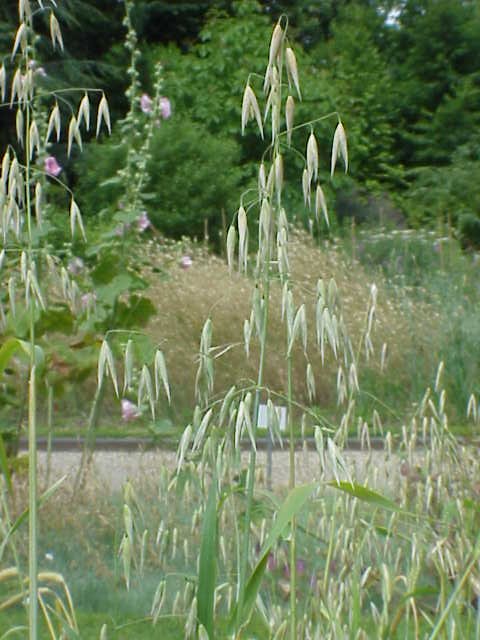- Avena
Taxobox
name = "Avena"

image_width = 200px
image_caption =Common Wild Oat , "Avena fatua" Note extreme similarity to Common Oat
regnum =Plantae
divisio =Magnoliophyta
classis =Monocotyledones
unranked_ordo =Commelinids
ordo =Poales
familia =Poaceae
subfamilia =Pooideae
tribus =Aveneae
genus = "Avena"
genus_authority = L.
subdivision_ranks =Species
subdivision = Around one dozen, see textThe oats ("Avena") are a
genus of 10-15species of true grasses (familyPoaceae ). They are native toEurope ,Asia and northwestAfrica . One species is widely cultivated elsewhere, and several have become naturalized in many parts of the world. All oats have edibleseed s, though they are small and hard to harvest in most species.Ecology
"Avena" species, including cultivated oats, are used as food plants by the
larva e of someLepidoptera species includingRustic Shoulder-knot andSetaceous Hebrew Character .For diseases of oats, see
List of oats diseases .pecies
Cultivated oats
One species is of major commercial importance as a
cereal grain. Four other species are grown as crops of minor or regional importance.* "
Avena sativa " – (Common) Oat, a cereal crop of global importance and the species commonly referred to as "Oats"
* "Avena abyssinica " – Ethiopian Oat, "a half-weed, half-crop confined to the highlands ofEthiopia ." [Zohary & Hopf (2000): p.78]
* "Avena byzantina ", a minor crop in the Near andMiddle East
* "Avena nuda " – Naked Oat or Hulless Oat, plays much the same role in Europe as does "A. abyssinica" in Ethiopia. It is sometimes included in "A. sativa" and was widely grown in Europe before the latter replaced it. As itsnutrient content is somewhat better than that of Common Oat, "A. nuda" has increased in significance in recent years, especially inorganic farming
* "Avena strigosa " – Lopsided Oat or Bristle Oat, grown forfodder in parts of Western Europe andBrazil Wild oats
These species, called wild oats or oat-grasses, are nuisance
weed s in cereal crops, as, being grasses like the crop, they cannot be chemically removed; anyherbicide that would kill them would also damage the crop.* "
Avena barbata " – Slender Wild Oat
* "Avena brevis " – Short Oat
* "Avena fatua " – Common Wild Oat
* "Avena maroccana " – Moroccan Oat
* "Avena occidentalis " – Western Oat
* "Avena pubescens " – Downy Oat-grass
* "Avena pratensis " – Meadow Oat-grass
* "Avena spicata " – Poverty Oat-grass
* "Avena sterilis " – Winter Wild Oat"Sowing wild oats" is a phrase used since at least the 16th century; it appears in a 1542 tract by
Thomas Beccon , aProtestant clergyman fromNorfolk . Apparently, a similar expression was used inRoman Republic an times already, e.g. byPlautus . The origin of the expression is the fact that wild oats, notably "A. fatua", are a major weed in oat farming. Among European cereal grains, oats are hardest to tell apart from their weed relatives, which look almost alike but yield little grain. The life cycle of "A. fatua" is nearly synchronous with that of Common Oat (see alsoVavilovian mimicry ) and in former times it could only be kept at bay by checking one's oat plants one by one and hand-weeding the wild ones when they were in flower but the grains had not ripened yet, lest the wild oats seeded themselves out. Consequently, "sowing wild oats" became a way to describe pointless activities. Given the reputation of oat grain to have invigorating properties and the obvious connection between plant seeds and human "seed", it is not surprising that the meaning of the phrase shifted towards more or less explicitly referring to the sexual liaisons of an unmarried young male, possibly resulting in children bornout of wedlock . [Quinion (1999)]Footnotes
References
* (1999): World Wide Words: [http://www.worldwidewords.org/qa/qa-sow1.htm Sow one's wild oats] . Web posted 1999-NOV-27. Retrieved 2007-OCT-17.
* (2000): "Domestication of plants in the Old World" (3rd ed.). Oxford University Press.
Wikimedia Foundation. 2010.
